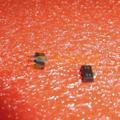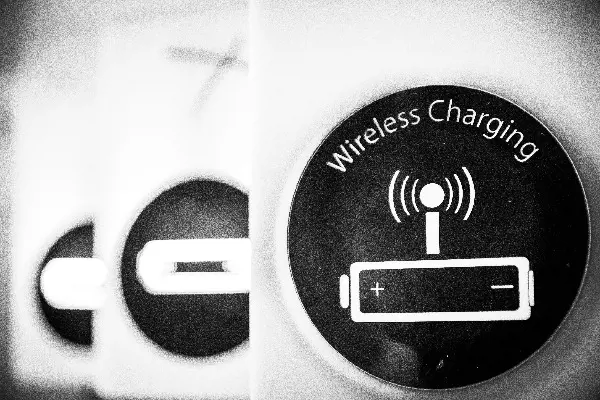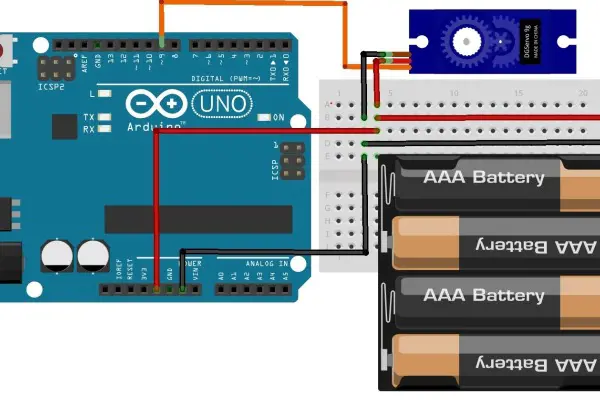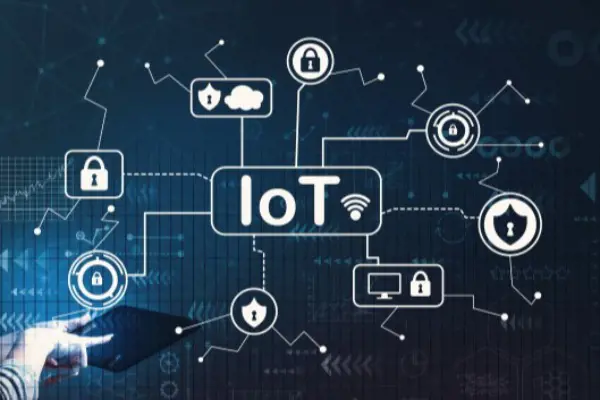ST Electric Vehicle Networking Solution
 Published: Apr 27, 2023
Automotive Electronics
Share:
Published: Apr 27, 2023
Automotive Electronics
Share:
The smart city concept is an important support for an efficient and sustainable society. Today, the majority of the world's population lives in urban centers, and research and development has found that the number of urban populations continues to grow.
Urban population growth is one of the main reasons for the increase of CO2 emissions. Smart cities mean that we need to adopt a city model that is characterized by energy efficiency, sustainability, and energy conservation and that improves the quality of life of city dwellers - a new strategy to address the global climate change challenge.
The emerging smart city model is an ecosystem of innovative technologies, including smart streetlights, smart meters, smart buildings, smart parking, and electric vehicles (E-Mobility). It is important to emphasize that these technologies must use different types of communication interfaces for the purpose of two-way information exchange. ST can provide all the interfaces needed for these technologies: WiFi, Bluetooth, RFSubGhz wireless communication and broadband/narrowband powerline communication.
In the context of smart cities, electric vehicles, both private and public, will be the fastest-growing application in the near future.
Plug-in Electric Vehicle and Smart Grid Charging Application Scenarios
Smart electric vehicles are an important player in smart cities. Sustainable urban mobility requires the integration of electric vehicle charging infrastructure in the smart city network. As a system component of a flexible smart city, EVs are required to support active demand response programs that help shift electricity demand to times of sufficient renewable energy supply and serve as additional renewable energy batteries.
For the purposes of this paper, plug-in electric vehicles (PEVs) refer to electric vehicles that can be recharged using an external power source, and there are two types of plug-in electric vehicles:
- Battery Electric Vehicles (BEV), commonly known as pure electric vehicles, are powered by an external power source and therefore do not have the internal combustion engine type engine found in conventional vehicles.
- Plug-in hybrid vehicles (PHEVs): are equipped with both a conventional internal combustion engine power system and an electric propulsion system.
To overcome the challenge of charging control for electric vehicles, a communication protocol needs to be implemented between the electric vehicle (EV) and the electric vehicle's power supply equipment (EVSE). Therefore, a signaling protocol has emerged in the market that transmits pulse width modulation (PWM) signals through a control lead wire inside the charging cable.
- Power supply device detects plug-in electric vehicle (PEV)
- Power supply device notifies PEV of power readiness
- Determine ventilation requirements for the plug-in electric vehicle
- Provide current capacity information of the power supply device to the plug-in electric vehicle
This technical specification originally appeared within the 2001 edition of the SAE J1772 standard and was subsequently referenced in the IEC 61851 standard.
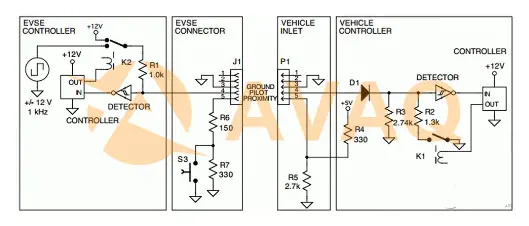
According to IEC 61851-1, the power supply sends a maximum effective charging power signal to the EV by adjusting the PWM duty cycle, while the EV returns four status signals that change the voltage value differently, as shown in the following figure:
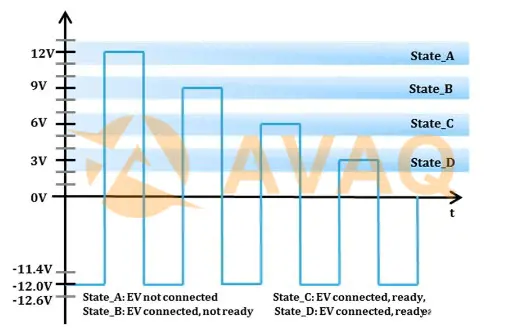
However, in practical smart grid applications, grid compatibility and fast charging management require more complex digital signals. This digital communication is currently specified in the Automotive Grid Communication Interface (V2GCI) of the ISO/IEC 15118 Joint Working Group Technical Standard. In conductive charging applications, the Power Line Communication (PLC) protocol is an application of ISO/OSI Layer 1 and 2 technology on the control lead line of the charging cable.
IEEE P1901 (HomePlug AV/GP) is the Broadband over Powerline (BPL) standard for IP-based powerline communication between electric vehicles and charging stations and smart grids. the HomePlug® Green PHY (GP) specification is a powerline communication protocol to meet the specific needs of smart grid applications, supporting communication between vehicles and the grid. It is compatible with both HomePlug AV products and the IEEE 1901 standard. The standard was developed by standardization organizations in collaboration with major electric utilities to significantly reduce power consumption and costs.
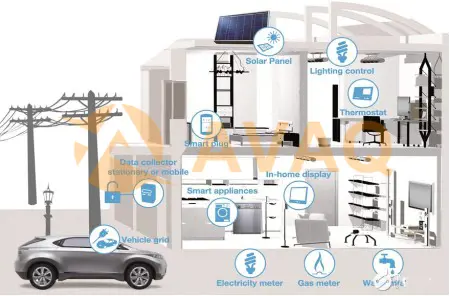
HomePlug GP can be seen as a simplified low-power, low-data-rate version of HomePlug AV, allowing chip manufacturers to develop easy-to-use, high-speed Green PHY chips. The standard's backward compatibility allows device manufacturers to deploy product prototypes and early development products using existing HomePlug AV chips.
In this context, ST's new ST2100 STreamPlug System-on-Chip (SoC) targets applications in the world's smart home and smart grid markets. The product is fully compliant with V2GI communication requirements and supports the HomePlug Green PHY technology specification, enabling automotive grid networking and active demand response applications.
ST2100 STreamPlug Overview
The ST2100 StreamPlug system-on-chip integrates a high-performance processing subsystem and powerline broadband communications (PLC) functionality with a security algorithm gas pedal and a variety of standard peripherals.The ST2100 supports the IEEE 1905.1 standard, allowing customers to integrate other networking standards such as Ethernet, Wi-Fi®, etc. within a new gateway or hub design.ST2100 StreamPlug supports widely used PLC communication protocols, such as HomePlug® AV and HomePlug Green PHY, as well as the IEEE 1901 standard for broadband powerline connectivity.
The ST2100 STreamPlug system-on-chip application processor is based on the 330MHz ARM926EJ-S core and provides an external memory management subsystem. In addition, the system-on-chip integrates USB 2.0 and Ethernet interfaces, a color LCD display controller and a CRYPTO hardware encryption engine that supports AES, DES/3DES and IPSec encryption algorithms.
The STreamPlug ST2100 chip comes in a 12mm x 12mm TFBGA 373 BGA package.
From a software perspective, the virtual machine supports guest OS management, e.g., Linux Kernel 2.6. PLC protocol support features include the latest IEEE 1901 Broadband Powerline (BPL) standard, as well as widely used HomePlug standards, e.g., 200Mbps HomePlug AV carrying HDTV and VoIP services, HomePlug AV optimized for smart HomePlug Green PHY optimized for smart grid applications.
These hardware and software architectures make the STreamPlug ST2100 Smart HomePlug system-on-chip an important enabling technology for the Internet of Things, which plays an important role in smart homes and smart grids.
ST2100 STreamPlug module
ST's T2100 STreamPlug system-on-a-chip co-development project with Taiwan-based Tatung has resulted in a number of innovations, such as Tatung's Gateway One network hub and other smart power products.Gateway One enables users to build multi-service carrier home networks that integrate Ethernet, WLAN, PLC and multimedia devices, increasing the opportunity to dramatically improve energy efficiency, security, comfort and convenience throughout the home. increasing the opportunity to dramatically improve energy efficiency, security, comfort and convenience throughout the home.
Tatung's Meter Bridge and Home Area Network (HAN) Bridge allow multi-unit homes to benefit from smart energy applications while solving challenges such as electricity usage and bills. The following highlights two modules, M1i and M3, developed for the OEM market. The M1i module is specifically designed for industrial applications, while the M3 targets smart home and smart building applications, including plug-in electric vehicle charging applications.
M1i Module
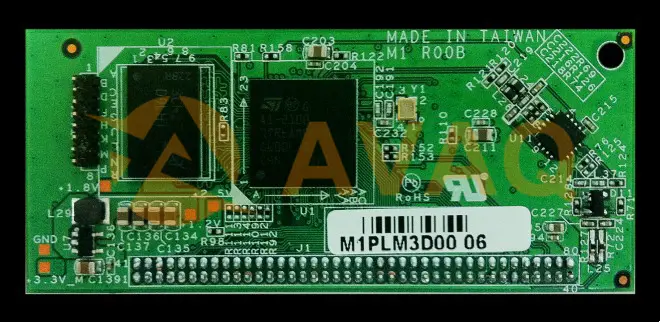
Industrial temperature range
Modular approach:
- Small size/area
- Integrated Subsystems - Optimized Board Layout
- Complete critical PLC subsystem layout within the module
Single chip integrated application processor, analog front end and HomePlug AV/GP
Wide choice of interfaces
Wide range of target applications:
- IoT and and machine-to-machine connectivity
- Home/building/factory automation
- Energy management
- Smart LED lighting
- Electric vehicles and electric vehicle powered devices
By using the expansion row of pins, the module also supports the following interfaces:
- HomePlug AV/GP (PLC)
- Ethernet
- USB (host or device)
- FSMC (multifunctional 8-bit parallel interface)
- GPIO (up to 24, PWM support)
- PGC (IR coding support)
- SPORT (high-speed DSP serial interface)
- TS (video/image sensor interface)
- DAI (I2S audio interface for audio DAC/ADC converters)
- SPI (3-wire and 4-wire serial control interface)
- UART (2 pcs)
- FIrDA (optional)
- I2C (Industry standard 2-wire serial interface)
- CAN (Automotive bus protocol based serial interface - 2 pcs)
M3 Modules
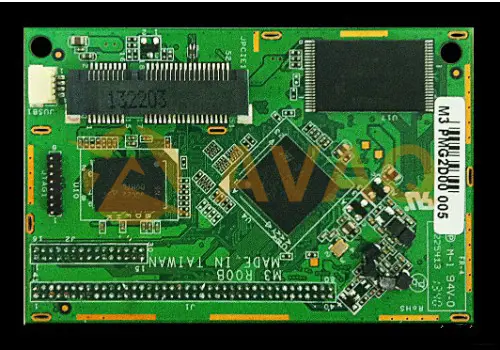
M3 modules are suitable for a variety of powerline communications in home area networks (HAN), industrial networks and intelligent networks: the
- IoT and and machine-to-machine connections
- Home/office/factory/building/city automation
- Energy management
- Intelligent LED lighting control
- Electric Vehicle Powered Equipment (EVSE)
- Audio/Video Transmission and Video Surveillance
- Display control
The M3 module is designed specifically for powerline communication systems, with built-in high-capacity NAND flash memory for storing applications and file systems, and supports a variety of interfaces via expansion pins:
- HomePlug AV/GP (PLC)
- Ethernet
- USB (host or device)
- FSMC (multi-function 8-bit parallel interface)
- GPIO (up to 24, PWM support)
- PGC (IR coding support)
- SPORT (high-speed DSP serial interface)
- TS (video/image sensor interface)
- DAI (I2S audio interface for audio DAC/ADC converters)
- SPI (3-wire and 4-wire serial control interface)
- UART (2 pcs)
- FIrDA (optional)
- I2C (Industry standard 2-wire serial interface)
- CAN (Automotive bus protocol based serial interface - 2 pcs)
M1i and M3 firmware
The STreamPlug software has three main modules: the ST interface layer with kernel scheduler, the ST system software and the hypervisor-based (aka virtual machine monitor) Linux kernel developed by Open Kernel Labs.
The ST interface layer with kernel scheduler provides the necessary APIs needed to support the system software layer and the system hypervisor; the ST system software provides the kernel software used to implement the HomePlugAV/1901/GP MAC as well as the support modules. specific hardware interfaces on the STreamPlugSoC and the hardware platform of the target application. The use of OKL technology to manage the Linux guest machine operating system has a number of benefits:
- Linux applications can run simultaneously with legacy applications and legacy operating systems on the same processor.
- Simultaneous support for two operating system environments eliminates the need to install multiple hardware processors and port legacy systems to the Linux operating system.
- With Secure HyperCell(tm) technology, OKL4 native units complete the Linux virtual machine (VM) functionality, providing a better execution environment, better real-time attributes and enhanced security.
- OKL4 units are suitable for managing real-time operating systems and simplify the implementation of latency-sensitive functions without sacrificing Linux's rich ecosystem support.
This robust and flexible software platform is an ideal runtime environment to support third-party proprietary protocol stacks and applications with enough processing power to run OpenADR, ISO/IEC 15118, OCCP and other software components to create a cost-effective and compact monolithic EV power device chip.
Conclusion
ST is the ideal partner to provide end device manufacturers with innovative technologies to help customers develop innovations in smart grid and IoT to optimize the end user's life experience.
Recommend Products
Related Solutions
-
![NXP Introduces High-Power Wireless Charging Solution for Laptops and 2-In-1 Tablets]()
NXP Introduces High-Power Wireless Charg...
NXP Semiconductors announced the first high-power wireless charging solution for notebooks and 2-in-...
Apr 28, 2023 Consumer Electronics -
![Multifunctional Street Light Automatic Control Circuit Solution]()
Multifunctional Street Light Automatic C...
The street light automatic controller is suitable for the automatic control of street lights in resi...
Apr 26, 2023 Consumer Electronics -
![How Can IoT Solution Providers Build a Secure IoT System at Different levels?]()
How Can IoT Solution Providers Build a S...
The Internet of Things (IoT) has been attracting a lot of attention in the industry for its security...
Apr 25, 2023 Consumer Electronics -
![ADI Proposes a Solution for Servo Motor Control]()
ADI Proposes a Solution for Servo Motor ...
For motor control solutions, ADI offers a comprehensive portfolio of products, including analog-to-d...
Apr 25, 2023 Consumer Electronics -
![IoT Transforms and Adds Value to Consumer Electronics Industry]()
IoT Transforms and Adds Value to Consume...
The Internet of Things (IoT) is taking consumer electronics to another level and could lead to the n...
Apr 26, 2023 Consumer Electronics -
![Texas Instruments Programmable Logic and Automation Controller (PLC/PAC) Solutions]()
Texas Instruments Programmable Logic and...
Programmable logic controllers (PLCs) and programmable automation controllers (PACs) process and con...
Apr 26, 2023 Consumer Electronics


 Update Time: Apr 27, 2023 Consumer Electronics
Update Time: Apr 27, 2023 Consumer Electronics

